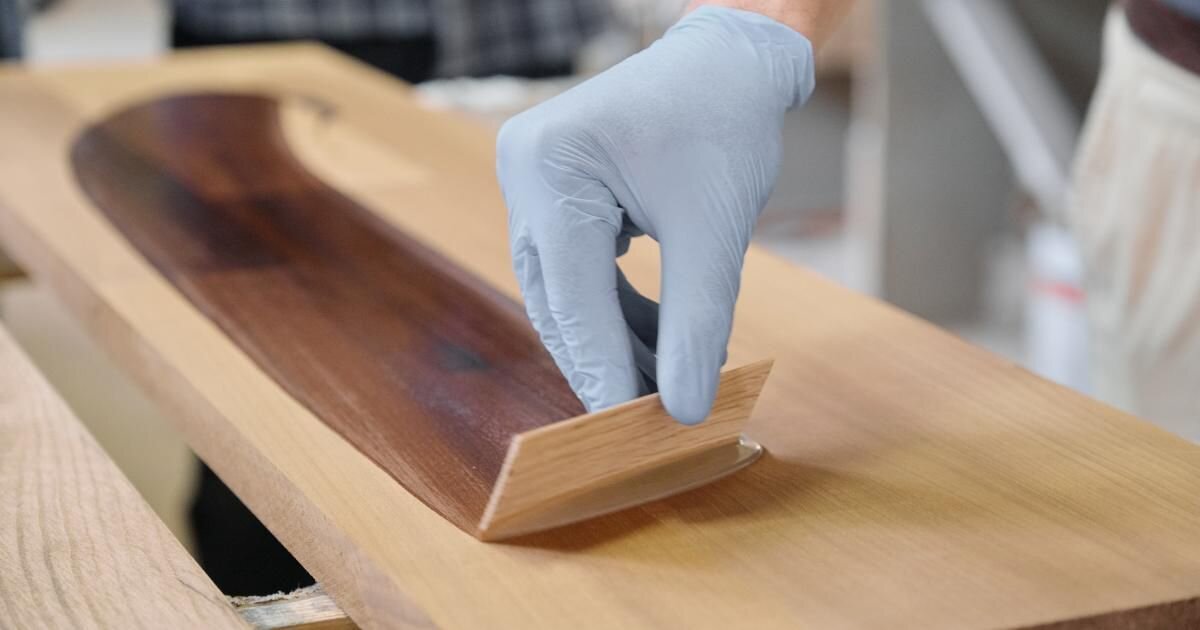Enhancing Your Cabinets: Exploring Different Wood Stain Options

Have you ever scrolled past a beautifully designed kitchen and wondered how those cabinets achieved that stunning finish? The secret is wood stain!
The choice of wood stain can make or break your cabinet makeover. It's more than just colour — it's about enhancing the natural beauty of the wood, protecting it, and ensuring it complements your home's decor.
In this blog post, we're sharing tips and tricks on wood stains. Your cabinets are more than just storage. They're a canvas for adding warmth, character, and style to your living spaces.
We are Craftsmen Hardwood, a wood products and services provider based in Drayton, Ontario. Since its inception in 1996, our business has grown significantly, now operating from a 35,000 square foot warehouse in Drayton's Industrial Park. We are known for our dependable service and quality products. Whether you’re interested in learning more about woodworking or have a custom cabinetry project in mind, please send us an email or give us a call and let’s connect. We are happy to help!
What are Wood Stains?
Wood stain is a specialized liquid or gel that is applied to wood surfaces to alter their colour and appearance. Its primary purpose is to enhance the wood's aesthetics while preserving and protecting it from wear, moisture, and UV damage.
There are various types of wood stains available, including water-based, oil-based, and gel stains.
- Water-based stains are environmentally friendly and dry quickly.
- Oil-based stains offer deeper penetration and durability.
- Gel stains are known for their easy application and control over colour consistency.
Wood stain brings out the wood's natural grain, texture, and unique features. It highlights the warmth and colour of the wood, adding depth to your cabinets.
Factors to Consider Before Staining
Before you run to the hardware store for a big bucket of stain, consider the following:
Cabinet Material and Type
- Different cabinet materials (e.g., hardwood, veneer sheet goods) may respond differently to staining.
- Consider the type of wood or material used in your cabinets, as it can affect how well it absorbs and retains the stain.
- The texture, grain, and natural colour of the wood will influence the final look, so choose a stain that complements these characteristics.
Desired Finish and Colour
- Determine the finish you want for your cabinets, whether it's a matte, satin, or glossy look.
- Select a stain colour that aligns with your overall design and home decor.
- Keep in mind that some stains may darken or lighten over time, so consider the long-term appearance.
- Test the stain on a scrap piece of wood to see how the stain interacts with your chosen wood type and ensure the colour is what you expect.
Budget Constraints
- Staining cabinets can vary significantly in cost, depending on factors like the size of your project, the quality of stain you choose, and whether you're doing it yourself or hiring professionals.
- Set a realistic budget that includes not only the cost of the stain but also any necessary tools, brushes, or equipment.
- Balancing quality and cost is essential, as investing in a higher-quality stain may lead to better results and longevity.
Other Eco-Friendly Options
- If you're environmentally conscious, explore eco-friendly wood stain options that use sustainable or non-toxic ingredients.
- Look for stains that have low VOC (Volatile Organic Compounds) content to minimize indoor air pollution.
Popular Wood Stain Colours
Classic Wood Stain Colours
Classic wood stain colours often include warm and rich tones like oak, which offers a timeless and traditional look. Mahogany stains create a deep and luxurious appearance, while walnut stains provide a darker, sophisticated finish.

These classic colours can add elegance and warmth to your cabinets and are suitable for various interior styles.
Trendy and Contemporary Wood Stain Colours:
Contemporary wood stain trends may feature cooler tones like grey, ash, or ebony, which can create a modern and minimalist aesthetic. Some trendy stains mimic the appearance of reclaimed or weathered wood, adding a rustic and vintage vibe to your cabinets.
Tips For Choosing the Right Stain Colour for Your Cabinets
- Consider your kitchen or room's existing colour scheme and decor to ensure your chosen stain complements the space.
- Test the stain on a sample board, not on your existing cabinets.
- Remember that the natural colour and grain of the wood will influence how the stain colour appears, so take this into account.
- Keep in mind that lighter stains tend to make spaces look more open and airy, while darker stains can create coziness and depth.
- If you're unsure, consult with a design professional or use online visualizers to preview how different stain colours will look in your space.
Step-by-Step Cabinet Staining Guide
Step 1: Prepare Your Cabinets for Staining
- Start by removing all cabinet hardware, such as handles, knobs, and hinges.
- Thoroughly clean the cabinet surfaces to remove dirt, grease, and any existing finishes.
- Sand the wood surfaces to create a smooth and clean base for the stain to adhere to.
- Repair any imperfections, such as scratches or dents, with wood filler or putty.
- Use painter's tape to protect adjacent surfaces or areas you don't want to stain.
Step 2: Choose The Appropriate Stain and Finish
- Select the wood stain that aligns with your desired colour and style.
- Consider the type of wood you're working with, as it can influence how the stain interacts with the grain and texture.
- Choose a finish (e.g., matte, satin, gloss) that matches your aesthetic preferences and the level of durability you need.
- Before applying stain to your entire project, experiment with it on a scrap piece of the same wood.
Step 3: Apply The Stain
- Apply the stain evenly using a brush, cloth, or sponge, following the wood's grain.
- Use long, smooth strokes to prevent streaks or blotches.
- Wipe off excess stain with a clean cloth to achieve the desired colour intensity.
- Consider techniques like layering, blending, or waiting longer to wipe off the stain to create unique effects, if desired.
Step 4: Let It Dry and Cure
- Allow the stained cabinets to dry completely according to the stain manufacturer's instructions.
- Ensure proper ventilation in the workspace to expedite drying and reduce odours.
- Some stains require a curing period to achieve maximum durability and hardness, so be patient and follow the recommended curing time.
Step 5: Add Protective Topcoats
- Apply clear protective topcoats (e.g., polyurethane, varnish) over the stained cabinets to seal and protect the wood.
- Multiple thin coats are often more effective than one thick coat for a smoother finish.
- Sand lightly between coats to achieve a smooth and even surface.
- Allow the topcoats to dry and cure fully to ensure the cabinets are adequately protected.
Maintenance and Care Tips
Regular maintenance of stained cabinets is important to preserve their beauty and durability. Dust with a soft cloth or duster to prevent dirt buildup. Mild wood cleaners and gentle cleaning techniques should be used for deeper cleaning. Apply wood polish or conditioner periodically to maintain the cabinet's shine. Use felt pads or bumpers to prevent scratches, and for more extensive damage, touch up with matching stain and reapply a topcoat.
DIY Cabinet Staining vs. Hiring Professionals
When deciding between DIY cabinet staining and hiring professional cabinet finishers, it's important to weigh the pros and cons of each approach.
DIY staining offers cost savings and a sense of accomplishment but requires time, skill, and the risk of mistakes, while professionals bring expertise, quality results, and time efficiency but come at a higher cost.
- Factors to consider include:
- Your budget
- The complexity of the project
- Your level of experience
- The desired level of finish quality
Making the right decision hinges on finding the balance between cost-effectiveness and the outcome you desire.
As always, we are here to support you in your woodworking or renovation project. We are known for our dependable service and quality products. Whether you’re interested in learning more about woodworking or have a custom cabinetry project in mind, please give us a call or send us an email and let’s connect. We are happy to help!


